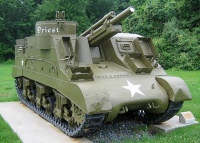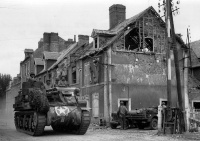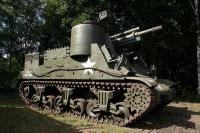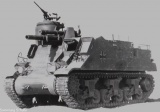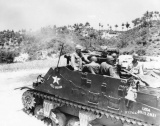M7 Priest
| Revision as of 14:41, 27 August 2011 | Revision as of 21:22, 11 October 2011 | |||
| Line 29: | Line 29: | |||
| }} | }} | |||
| {{panel title|icon=[[image:USA-M7 Priest.png|link=|left]]|rMargin=248px|content= | {{panel title|icon=[[image:USA-M7 Priest.png|link=|left]]|rMargin=248px|content= | |||
| ? | Probably the most famous self-propelled gun in history, the M7 Priest retains many of | + | Probably the most famous self-propelled gun in history, the M7 Priest retains many of its excellent qualities in-game. The Priest's stock engine is quite good for an SPG, although it's turn rate is woeful. You cannot mount the upgraded gun without increasing your weight limit, so better tracks should probably be your first purchase. With the upgraded M2A1 gun, the Priest can rain death and destruction across the entire map. The M7 is based on the tried and tested Sherman chassis, and the same upgrades can be used on many other [[USA]] tanks. So if you have some spare experience, they are a good investment. The Priest leads directly to the [[M41]] SPG. | |
| }} | }} | |||
| {{Modules | {{Modules | |||
Revision as of 21:22, 11 October 2011
M7 Priest
| USA | SPG | Tier IV |
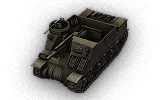
Probably the most famous self-propelled gun in history, the M7 Priest retains many of its excellent qualities in-game. The Priest's stock engine is quite good for an SPG, although it's turn rate is woeful. You cannot mount the upgraded gun without increasing your weight limit, so better tracks should probably be your first purchase. With the upgraded M2A1 gun, the Priest can rain death and destruction across the entire map. The M7 is based on the tried and tested Sherman chassis, and the same upgrades can be used on many other USA tanks. So if you have some spare experience, they are a good investment. The Priest leads directly to the M41 SPG.
Modules
Historical Info
The 105 mm Howitzer Motor Carriage M7 was an American self-propelled artillery vehicle produced during World War II. It was given the official service name 105 mm Self Propelled Gun, Priest by the British Army, due to the pulpit-like machine gun ring, following on from the Bishop and the contemporary Deacon self-propelled guns.
History
Witnessing the events of the war, U.S. Army observers realized that they would need a self-propelled artillery vehicle with sufficient firepower to support armored operations. Lessons learned with half-tracks (such as the T19) also showed that this vehicle would have to be armored and fully tracked. It was decided to use the M3 Lee chassis as the basis for this new vehicle design, which was designated T32.
After reworking the M3 by providing an open-topped superstructure, mounting a 105 mm howitzer and, following trials, adding a machine gun, the T32 was accepted for service as the M7 in February 1942 and production began that April.
While the first M7s were produced for the U.S. Army, supply was soon diverted to support the Lend-Lease program. Ninety M7s were sent to the British 8th Army in North Africa, who were also the first to use it in battle during the Second Battle of El Alamein as well as their own Bishop: a 25-pounder, howitzer-armed self-propelled gun. The M7 soon proved successful and the British requested 5,500 of them: an order which was never fully completed. They did find problems with the M7 though, as the primary armament was of U.S., not British standard. This meant that the M7s had to be supplied separately, causing logistical complications. It was a problem that was only truly resolved in 1943 on arrival of the 25-pounder-armed Sexton developed by the Canadians on a similar chassis. Until that time though, the British continued to use the M7 throughout the North African Campaign, the Italian Campaign, and even a few during the early days of the Normandy Invasion. After the Sexton appeared, most British M7s were converted into "Kangaroo" armored personnel carriers.
In U.S. service, the M7 was a great success. Each U.S. armored division had three battalions of M7s, giving them unparalleled mobile artillery support.
A total of 3,490 M7s were built, and they proved to be reliable weapons, continuing to see service in the U.S. and allied armies well past World War II.
Variants
- M7 --The first M7s produced were modified M3 Lee medium tanks. In order to maintain a low silhouette, the howitzer elevation had to be restricted to 35°. In May 1942, after only a month of production, the vehicle was altered to increase it's ammunition storage from 24 to 69 rounds. This was achieved by placing seven rounds on the left wall, five on the right, and storing the remainder under floor plates. The M7 also went through a fairly rapid shift from being based on the M3, to having more commonality with the M4 Sherman. The first major example was an adoption of the M4's three-piece housing, single piece casting, and suspension. In British service, some M7s carried a radio set, which took the place of 24 rounds of ammunition.
- M7B1 -- Completing the shift, the M7B1 was fully based on the M4A3 Sherman chassis. It was standardized in September 1943, and declared the "substitute" standard in January 1945.
- M7B2 --During the Korean War, the limited elevation of the howitzer became noticeably problematic and it was increased to 65° to increase the effective range of the howitzer. The machine gun mount also had to be raised to give a 360° firing arc.
- Defrocked Priest -- As one part of the Allied effort to capture Caen and breakout from the Normandy beaches, several M7s had their main gun removed in the field for use as armored personnel carriers and were used in Operation Goodwood. These field modified vehicles were referred to as "Defrocked Priests."
- Kangaroo -- A Canadian armored personnel carrier (APC) conversion of the M7 for use by British and Commonwealth units in northern Europe. The Kangaroo could carry 20 infantry plus a crew of two. A total of 102 were converted between October 1944 and April 1945. The name "Kangaroo" became generic for all APC conversions of armored fighting vehicles no longer suitable for combat, including Ram conversions.
External links
| Light Tanks | T1 Cunningham • M2 Light Tank • T1E6 • T2 Light Tank • T7 Combat Car • M22 Locust • M3 Stuart • MTLS-1G14 • M5 Stuart • M24 Chaffee • T21 • T71 |
| Medium Tanks | T2 Medium Tank • M2 Medium Tank • M3 Lee • M4 Sherman • M4A2E4 Sherman • M7 • Ram II • M4A3E2 Sherman Jumbo • M4A3E8 Sherman • T20 • M26 Pershing • T23 • T26E4 Super Pershing • T69 • M46 Patton • T54E1 • M48A1 Patton • M60 |
| Heavy Tanks | T1 Heavy Tank • T14 • M6 • T29 • M6A2E1 • T32 • T34 • M103 • T57 Heavy Tank • T110E5 |
| Tank Destroyers | T18 • T82 • M8A1 • T40 • M10 Wolverine • T49 • M18 Hellcat • M36 Jackson • T25 AT • T25/2 • T28 • T28 Prototype • T30 • T95 • T110E3 • T110E4 |
| Self-Propelled Guns | T57 • M7 Priest • M37 • M41 • M44 • M12 • M40/M43 • M53/M55 • T92
|
| USA | II T1 HMC • III T18 HMC • III M7 Priest • IV T82 HMC • IV M37 • V M41 HMC • VI M44 • VII M12 • VIII M40/M43 • IX M53/M55 • X T92 HMC |
| UK | II Loyd Gun Carriage • III Sexton II • III Sexton I |
| Germany | II G.Pz. Mk. VI (e) • III Sturmpanzer I Bison • III Wespe • IV Pz.Sfl. IVb • IV Sturmpanzer II • V Grille • VI Hummel • VII G.W. Panther • VIII G.W. Tiger (P) • IX G.W. Tiger • X G.W. E 100 |
| France | II Renault FT 75 BS • III Lorraine 39L AM • IV AMX 105 AM mle. 47 • V AMX 13 105 AM mle. 50 • V 105 leFH18B2 |
| USSR | II SU-18 • III SU-26 • IV SU-5 • V SU-122A • VI SU-8 • VII S-51 • VII SU-14-1 • VIII SU-14-2 • IX 212A • X Object 261 |
| China | |
| Japan | |
| Czechoslovakia | |
| Sweden |





